Photos, videos and documents related with the local food
Some photos of Italian typal food:
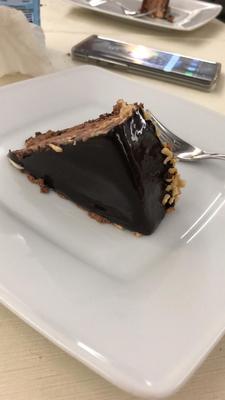
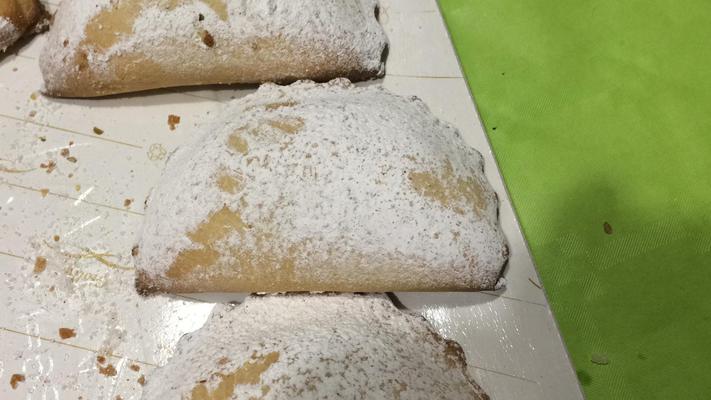
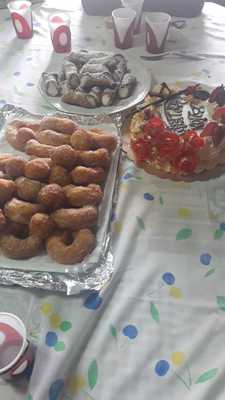
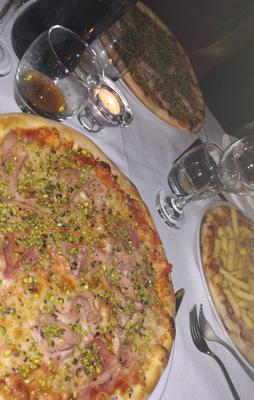
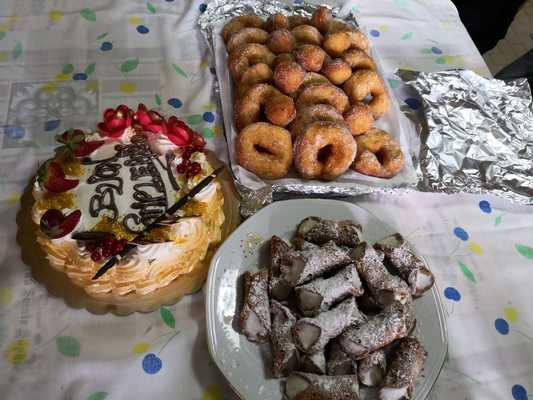
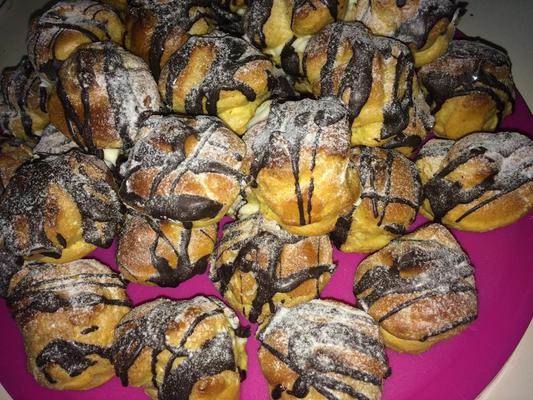
P3 Activity: Acquiring information on typical local food
Being a community of shepherds, the local people from the Jiu Valley cook every autumn a traditional recipe, which is the mutton jelly.
It is a ready-made sheepmeat dish prepared towards the end of autumn to be consumed in the cold season. Only fat animals are sacrificed for its preparation: sheep without young, rams, wethers etc. The meat is cut into small pieces, suitable for roasting. The meat is fried in its own fat. When the meat is half roasted, add salt to taste. The meat will boil in its own juice until it clears off the bone. In this phase add small chopped onions, garlic, bay leaves and basil.
In the traditional village, the mixture is poured into wooden pots, taking care not to form air voids and fat to cover the whole meat. The fat layer on the surface will strengthen with cooling and isolate the meat preventing it from being damaged. The pots are stored in the cold cellars.
When wanting to eat it, cut the desired quantity from these dishes, heat up and consume with warm polenta.
Starting from the traditional recipe for the preparation of mutton jelly, Emil Părău, owner of S.C. COMEXIM Lupeni has "patented" the recipe of mutton jelly and called it `Montana`.
The elements that have improved the product quality are:
- the boiling of the meat is made exclusively in mutton fat without adding pork fat;
- only young fatty sheep are used;
- the meat does not boil on the bones, it is removed before boiling;
- at the end of boiling, for meat-fat homogenization, the composition is minced to obtain a uniform paste;
- the paste is introduced into thick intestines.
The information was collected while the students visited the Retezat Guest House, owned by Mr. Parau, on 7 May 2019.
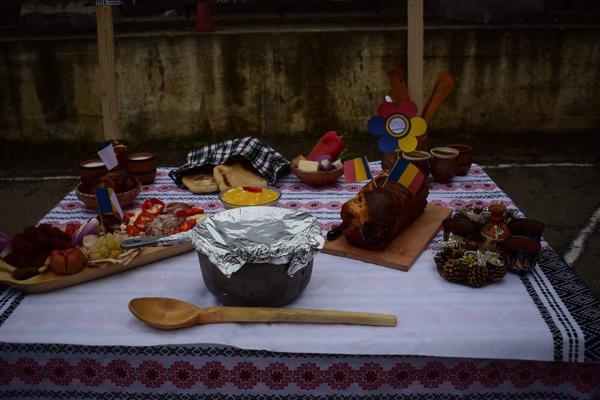
Photo taken on 1 December 2018 activity organised at ~Mihai Eminescu~ National College (Photo credit: Iulia Galdean, student at ~Mihai Eminescu~ National College, grade 10A)
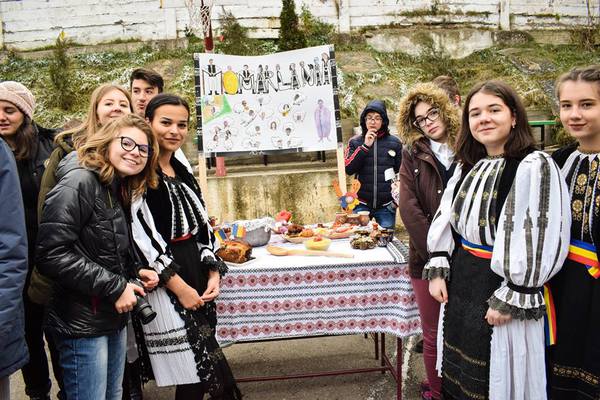
Photo taken on 1 December activity. The students who represented the local people, ~momarlani~ (Photo credit: Ioana Terteci, student at ~Mihai Eminescu~ National College, Petrosani, grade 11B)
P7 ACTIVITY
EDUCATIONAL VISIT TO A BUFFALO FARM AT LAKE KERKINI (P7.2. ACTIVITY - 2 GENIKO LIKIO HORTIATI)
The Greek pupils of A’ Class visited a buffalo farm in the area of Lake Kerkini, Serres. We have chosen to visit a buffalo farm because buffalo breeding is an important sector of preserving the local resources, taking into account that buffalos are threatened with extinction. In addition buffalos grazing around lake Kerkini is a favorite sight for the tourists. Buffalo products, such as buffalo milk, ice-cream, “kazandipi” and “bougatsa” traditional sweets, cheese, pasta and meat are of great taste and nutritional value and are typical traditional dishes of the restaurants, enhancing the gastronomic tourism of the area.
As for the history, according to the prevailing view, the Greek buffalo (Bubalus bubalis) has been imported from Asia. The first appearance of large populations of buffalos in Greece is placed in the 13th century. In 1952 only 71.000 buffaloes were bred in Macedonia and Thrace. In 2004, their number dropped to 1.012, while nowadays, around 3,200 waterbuffalos are bred mainly in Northern, Central and Western Greece. However, 80% of the total population, about 2.500 animals, is concentrated in the area of Serres.
On the world map, Asia is the first in buffalo breeding with about 161 million water buffalos out of a total of 172 million (96% of the world's population). In Europe, the breeding of this animal is limited to a few countries, with Italy, Greece, Romania and Bulgaria having the most significant production, and a few hundreds of water buffalos are also found in England, Germany, the Netherlands and Hungary.
The Livestock Association of Greek Buffalo Breeders, the only one in the country, was founded in 2004 with the aim of genetically improving and promoting the Greek buffalo. Nowadays, domestic buffalobreeding is only a small part of the livestock industry. However, in recent years, it has been gaining ever more ground and recognition, thus preserving the identity of the Greek waterbuffalo, which was in danger of extinction. Greek buffalo breeders firmly believe in the multiple benefits of buffalo breeding. The products of buffalo (milk and meat) are much in request inside and outside the Greek borders due to their high nutritional value, offering a satisfactory income to the breeders. 100 grams buffalo meat has only 130 calories, when the corresponding quantity of beef has 260-300 calories, lamb 241 and turkey 323, while its iron is at 2-3% when the calf reaches only 0.3%. As for buffalo milk, it contains 58% more calcium and 40% more proteins than cow's and goat's. Buffalo milk has beneficial effects on the body, while it is suitable for those who have allergies, psoriasis, eczema or lactose intolerance. It is recommended as a food for the weak or the patients. It contains less water, more total solids, fat and protein and a little more lactose than cow's milk. It has lower levels of cholesterol and higher calcium, higher iron, phosphorus, vitamin A and protein. Its antioxidant action is greater than other types of milk and contains more vitamins, such as thiamine, riboflavin and B12.
The owner of the buffalo farm we have visited and member of the Livestock Association of Greek Buffalo Breeders, Andreadis Andreas, pointed out that the sector of buffalobreeding remains dynamic with huge prospects - especially in the areas of processing and marketing of buffalo products that are still in the embryonic stage - but if its viability is not ensured, then it will again be shrunk. The main black spots of the buffalo industry and the threats to the future of the sector are, inadequate pastures, the lack of arable land for animal feed and the considerable delay in paying aid to indigenous animal breeders.
The cost of farming is large and up to 850 euro per animal until the production process begins, mainly because of the feed, corn and clover. The Greek buffalo is subsidized with amounts ranging between 170 and 315 euros per animal to maintain it and its 30% annual increase, so thanks to these funds the investment costs are reduced for a new entrant in the area. The oldest breeders, have the potential to carry out infrastructure projects in order to exploit their products. However, a thorn is the fact that there are long delays in the payment of subsidies.
The number of buffalos is relatively easy to grow, he explained, adding "as long as space allows." And that's where the biggest problem of buffalo-breeders is. The issue of land reclamation, in order to give land to landless people, deprives the natural environment of the buffalos in lakes and, of course, their grazing. Buffalo owners in Lake Kerkini are forced to grow corn and straw to feed the animals, which increases operating costs and significantly reduces profits. Another problem faced by buffalobreeders is that of stables.
As Mr.Andreadis told us, "when one buys the herd, the animals should be one year old. In the next year they will mate and give birth. They produce milk for five months. The amounts per female are 40 to 50 kilos. The price of milk ranges from 1.20-1.30 euros/Kg. In the second year it can also be slaughtered. Each animal draws around 200-230 Kg of meat. Its price is close to 4.5 euros/kg. And at the age of one year the buffalo can be slaughtered and the meat will be at 120 Kg" he explained. He pointed out that "approximately, the farmer could have a 20.000 euros income in the second year."
He also emphasized that the first thing one must secure in order to breed buffalos, is to find a place to manage them, that is to say wetlands, swampy places, and added, "He can start with a small flock, for example, with 20 animals. Each animal costs 700 euros". However, he pointed out to us that "if someone opens a shop for selling, for example, traditional “bougatsa” and ice cream with buffalo milk, he will have more profit”. Speaking about his plans, he was confident that his goal was to create a dairy.
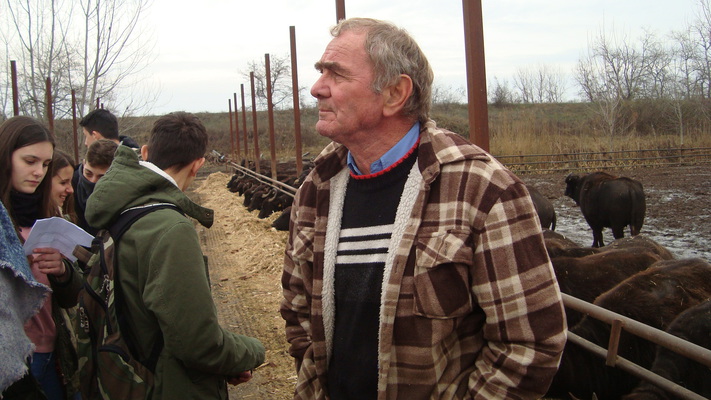
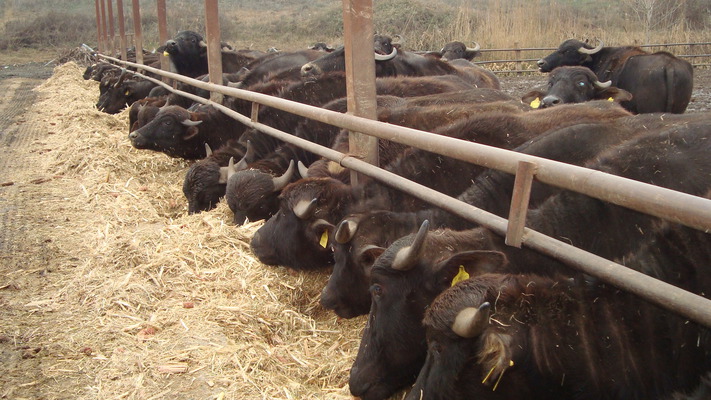
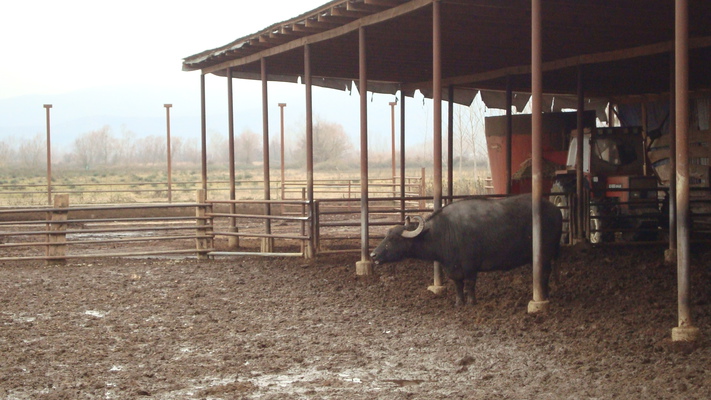
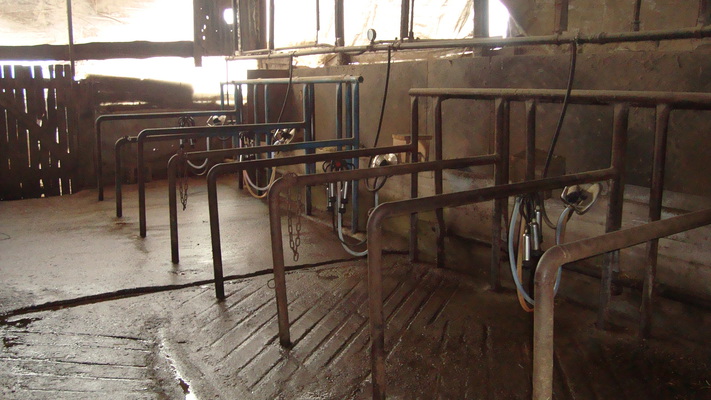
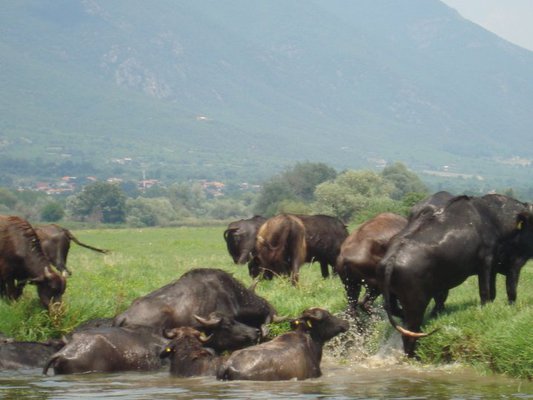
References: https://www.ypaithros.gr/ekdoseis/ektrofi-nerovouvalou/
P 12 Activities. Nedeia Troitei. Parang Tourist Resort. 15 August 2019
While the Romanian students from the target group participated in Nedeia Troitei in the Parang Tourist Resort on 15 August 2019, they learned form the local people who prepared traditional food at this pastoral festival how to make coarse cornmeal with cheese and mutton soup.
Coarse cornmeal with cheese
The corn coarsely ground (named “coarse cornmeal”) is “soaked in water”, from evening till morning. The chaff that comes to the surface settles. We fill in a copper pot with water, after it has been greased, so that the coarse cornmeal does not stick. Three or four buckets of coarse cornmeal are put in the boiling water. In this operation two chefs participate: one who stirs continuously and the other one who pours, slowly, the coarse cornmeal. In the copper pot you have to stir all the time with a long wooden stick, especially crafted for this. The copper pot for the coarse cornmeal is made of copper and it has a capacity of 40 liters. In the traditional village, thelocals used the copper pot that was used by shepherds for the preparation of the ”whey mixed up with urda”, having the capacity of 80 liters. The disadvantage was that when it was needed in the summer, they had to bring it from the mountain. Now every parish (and every village) has its own pot. Duringthe boiling of the coarse cornmeal the plaguechaff is removed and, if necessary, the foam. When the coarse cornmeal is boiled, we add 20-30 butter or margarine packages. The pot is removed from the fire and we add 10-12 kg of sheep shredded cheese. All this time the coarse cornmeal is stirred, and the quantity of cheese can be supplemented, to taste. No cow cheese is added because it is not creamy enough and, moreover, at high temperature it spreads. The fasting coarse cornmeal, contains margarine, oil and sugar instead of butter and cheese which are dairy food. Coarse cornmeal is a tradtional food for population of the Jiu Valley for holidays and almses.
Mutton soup
With the coarse ground cornmeal, mutton soup is the delight of the people from the Jiu Valley. This is cooked in big copper pots or cast iron pots of 50-60 liters each. Prepared in copper pot, the soup will have a special taste. The sheep meat is cut into small pieces, to fit in the spoon, avoiding the big bones. The meat is washed 2-3 times till the blood stains disappear. Boil about 20 kg of meat in cold water in each pot. The foam resulting in the boiling process is removed all the time with a big wooden spoon. When the meat is half boiled, the salt is added and the finely chopped onion. You can add spices like thyme and pepper. When the meat is boiled, we add the fried onion. Fry the chopped onion well in a greased pan. If the meat is weaker, add sheep grease. This is poured in the pot and “a souce” is made with yoghurt or sour cream mixed with white flour. The composition is well mixed and, cold like that, is put in the boiling pot. Now add the paprika, grated carrots and parsley. In the past, boiled meat was used in its own juice. Now, some chefs add even tomato paste in the sauce.
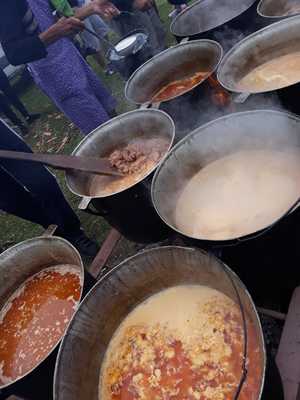
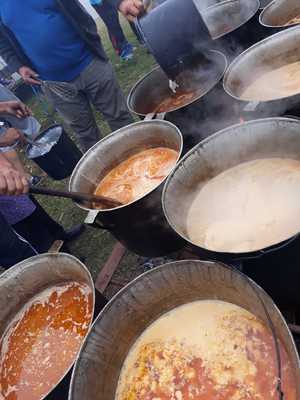
Cast iron pots with boiling mutton soup
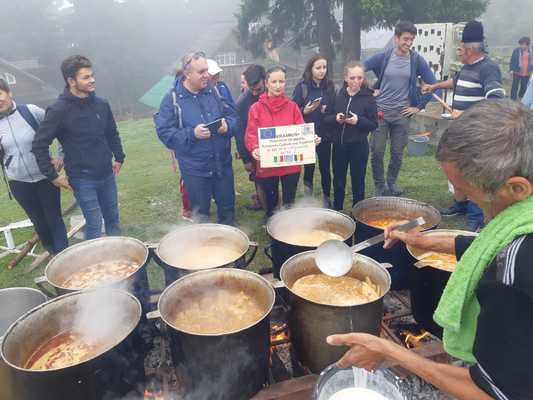
One of the chefs adding sour cream mixed with white flour
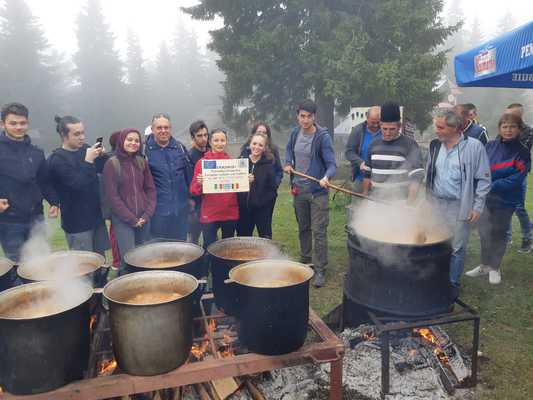
Denis Raducan, member of the target group, stirring in the copper pot with boiling coarse cornmeal
SARMALE
BRIEF HISTORY
Sarma is a dish of vine, cabbage, monk's rhubarb, kale or chard leaves rolled around a filling of grains, like bulgur or rice, minced meat, or both. It is found in the cuisines of the former Ottoman Empire from the Middle East to Southeastern Europe.
In the Turkish provinces of Amasya and Tokat sarma is prepared in a style similar to maklouba, with different fillings. One version made with fava beans is called bakla sarma. The filling for this variant from Amasya is made with dried fava beans and a coarsely ground wheat called yarma. Tomato paste, water, sunflower oil, chopped onion, aleppo pepper and spices are added to complete the mixture. Bone-in lamb chops are tightly layered on the bottom of the pot and the wrapped sarma are added on top of the lamb. Butter is added on top and the sarma are cooked together with the lamb chops in water. The finished dish is served upside down.
In Romania and Moldova, sarmale is popular in all historical regions, Moldavia, Transylvania, and Wallachia. It usually consists of minced pork, rice, onion, eggs, thyme and dill rolled in a leaf, usually a cabbage leaf. The baking dish is lined with chopped cabbage and sauerkraut layered with bacon or pork belly and the cabbage rolls, then topped with more sauerkraut and dill sprigs. The cooking water is poured over the assembled tray, a mixture of sauerkraut juice and seasonings. It is typically accompanied by mămăligă (polenta) and smântână (sour cream). It's a traditional dish to be served for Easter and Christmas meals.
A version of sarmale is also made in Serbia.
In Romania sarmale are usually made around Christmas and other special ocasions.
INGREDIENTS
- minced pork 1kg
- pickled cabbage, around two whole cabbages
- 3-4 onions (small)
- 2-3 cups rice
- smoked pork
- H2O
- liquid fat
- carrot
-Thyme, dill and bay
-tomato sauce
PREPARATION
1. Preferably, if the caggabe is already pickled you could leave it ain a bowl of water overnight. Otherwise the sarmale will end up too salty.
2. Dice up the onions, shred the carrot, and drop these into the sizzling fat (or oil). After everything gets nice and soft add the rice and toast it for a bit
3. Season the meat with salt, pepper, thyme, dill and bay and mix it with the rice, onions and carrot.
4. Take the leaves, fill them up with a moderate amount of mixture and wrap tightly.
5. Lay the sarmale in the earth pot (If you’re using an oven. You can also use a pot if you’re using a stove)
6. Lay a few pieces of the smoked pork, You can also add the bone for extra flavour
7. Inbetween the layers of sarmale pour a healthy glug of tomato sauce.
8. Add water until it reaches halfway
9. Leave in the oven at around 280C for however long it takes to boil
10. Take them out the oven and serve with sour cream.
The recorded recipe can ve watched on YouTube: https://youtu.be/Hc8INftsgZY
By Stelian Tetileanu
Mucenci recipe
Mucenici is a traditional feast here in Romania; we cook them with the occasion of the 40 Martyrs of Sebaste. This Holiday is celebrated in Moldova and Romania. Some believe that when the Martyrs drowned, flowers rose on top of the water so now, today, on the 9th of March we have this dessert named mucenici, which means martyrs in Romanian.
Ingredients needed:
- 300 g of flour
- 100 ml of milk
- 5 g of vanilla sugar
- 5 g od dried yeast mixed with one tablespoon of water
- 200 grams of sugar
- 2 eggs
- 80 grams of walnuts
- 50 grams of butter, melted
- 2 tablespoons of honey
Instructions:
In a mixing bowl add the flour and the dried yeast mixture, in a smaller bowl whisk the eggs together with the vanilla and the regular sugar. When well mixed, add the eggs and sugars along with the melted butter to the mixing bowl. Turn on the mixer and continue mixing until the ingredients well combined.
After approximately 5-6 minutes of mixing, add half of the milk and continue mixing for approximately 5-10 minutes.
If your dough is too thin or too thick no worries! You can always add some more milk of flour to fix it.
Now we got to put or hands to work, start mixing it by hand. Not going to lie, it’s going to take like 30 minutes.
When we finish mixing it we have to let it sit for at least one hour, great chance to rest our hands after all the mixing: D. White the dough is resting, get a blender and crush those walnuts. Then turn on your oven to preheat at 220 C degrees. Make sure you ask an adult for help here.
After the dough has sat for an hour, you want to put some oil in your table/kitchen counter and start shaping you mucenici.
Take a small piece of dough and roll it in the table, make it kind of like a snake. Stick the ends to each other and make a shape like the infinity sign. Now we slam our mucenici in the oven for about 30 minutes.
While your mucenici are baking, you are going to take a small pot and warm up the honey with the rest of the milk, make sure to mix them well.
You might have to strain it before using, but I promise you it’s worth it.
Now you cover you mucenici with the syrup formed of milk and honey, and then cover them with walnuts. You can add other ingredients on, I used some coconut flakes too, but it’s really up to you if you want to add anything else like maybe chocolate or sprinkles.
Trick: if you still have some syrup after covering all the mucenici just pour it in the pan. The mucenici will absorb the syrup and the flavor will be amplified.
We slam them back in the oven for another 5 minutes, after this they are good to serve! <3
This is one of my favorite deserts ever, especially served with a cup of warm milk. Mucenici is a very important dish for our culture, I hope you will try and enjoy it as much as I do.
By Paula Pricop
Beans and sausages
•INGREDIENTS:
500g of beans
7 pieces of sausages
One onion
2 carrots
1 parsley
1 green parsley
1 parsnip
1 red bell pepper
5 garlic cloves
1 bay leaf
Salt and papper
3 tablespoons of sunflower oil
One tablespoon of tomato paste
•PREPARATION:
Boil water in deep pan, when the water is boiling add the beans. In a separate pan add the oil and choppes sausages until they cook through, then add diced onion and let sit for 3-4 minutes.
In the same pot add the tomato paste and the chopped vegetables
Sir fry them for about 2-3 minutes, then add the drained beans, water to cover the contents and the bay leaf
Allow the contents to boil over medium heat until the beans are fully cooked through. Ultimately, add the garlic and the green parsley to the pot and let it simmer for about 2 minutes over medium heat.
By Bianva Barlida
PRESENTING RECIPES WITH CHIOS MASTIHA (P22.1. ACTIVITY - GENIKO LIKIO HORTIATI)
In June 2020 the pupils of the Erasmus+ project studied the traditional product “Chios Mastiha”.
Mastiha is a natural resin that comes from an evergreen small tree, called Schinos, which is cultivated successfully in the island of Chios, in the Eastern Aegean Sea.
The name “Chios Mastiha” has Protected Designation of Origin (PDO) status in the European Union since 1997.
Mastiha has been harvested for at least 2.500 years since Greek antiquity. The first mention of actual mastic 'tears' was by Hippocrates. Hippocrates used mastiha for the prevention of digestive problems, colds and as a breath freshener. Roman emperors used mastiha along with honey, pepper and egg in the spiced wine conditum paradoxum. Digestive liqueurs, similar to Mastiha but made with grapes, were known as the Greek elixirs before the French Revolution
Nowadays mastiha has many uses due to its exquisite taste and flavor as well as its therapeutic characteristics; it is used in chewing gums, delights with mastic, mastiha liqueurs, ingredient of medicines. Also we can use mastic in several recipes.
The pupils of the Erasmus+ project studied recipes with mastiha and prepared a relative presentation. You can find the presentation at:
GR_P_22 MASTIHA RECIPES.pdf
PRESENTING THE RECIPE OF THE GREEK TRADITIONAL DISH “LIMA BEANS” (GENIKO LIKIO HORTIATI - P24 ACTIVITY)
In August 2020 the pupils of the Erasmus+ project studied the recipe of the Greek traditional dish “lima beans” and prepared a relative presentation.
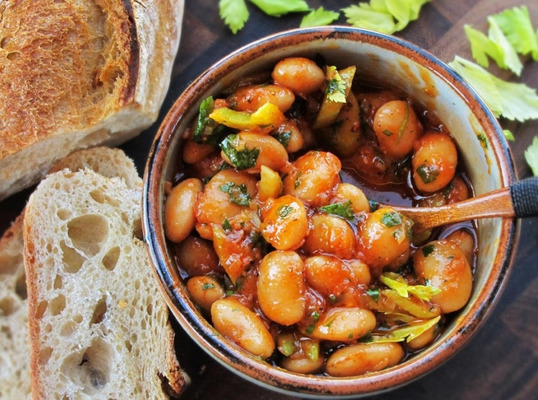
You can find the presentation at:
GR_P_24_LIMA BEANS.pdf
PRESENTING THE RECIPE OF THE GREEK TRADITIONAL DISH “KONTOSOUVLI” (P27 ACTIVITY - GENIKO LIKIO HORTIATI)
In November 2020 the pupils of the Erasmus+ project studied the recipe of the Greek traditional dish “kontosouvli” and prepared a relative presentation.
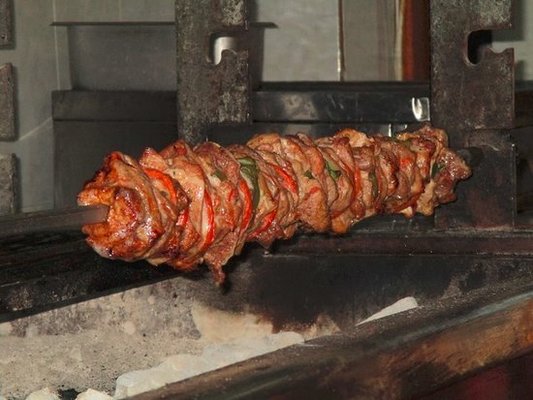
You can find the presentation at:
GR_P27 RECIPE KONTOSOUVLI.pdf
PRESENTING THE RECIPE OF THE GREEK TRADITIONAL DISH “MOUSAKAS” (GENIKO LIKIO HORTIATI - P29 ACTIVITY)
In January 2021 the pupils of the Erasmus+ project studied the recipe of the Greek traditional dish “mousakas” and prepared a relative presentation.
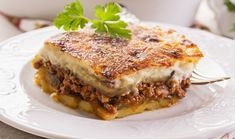
You can find the presentation at:
GR_P29 RECIPE MOUSAKAS.pdf
STUDYING THE TRADITIONAL PRODUCT “KROKOS KOZANIS” (GENIKO LIKIO HORTIATI - P35 ACTIVITY)
In July 2021 the pupils of the Erasmus+ project studied the traditional product “Krokos Kozanis” and prepared a relative presentation.
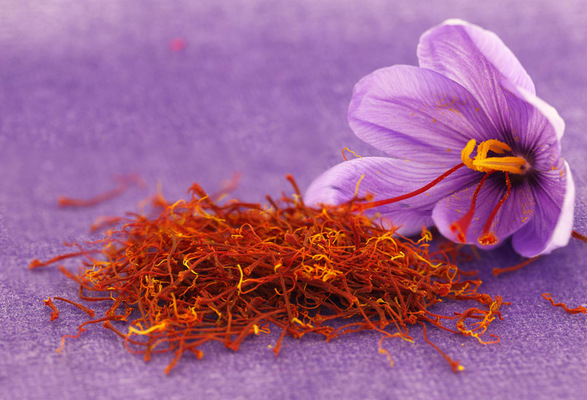
The name “Krokos Kozanis” has Protected Designation of Origin (PDO) status in the European Union.
You can find the presentation:
GR_P35_KROKOS.pdf
STUDYING THE TRADITIONAL GREEK CHEESE “FETA” (GENIKO LIKIO HORTIATI - P36 ACTIVITY)
In August 2021 the pupils of the Erasmus+ project studied the traditional Greek cheese “Feta” and prepared a relative presentation.
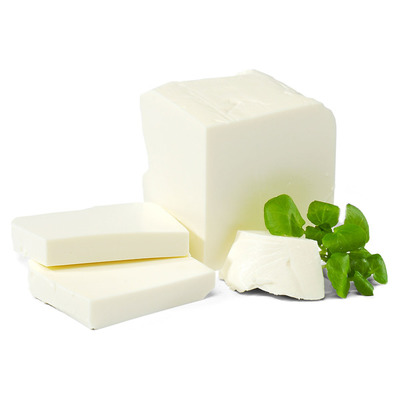
The name “Feta” has Protected Designation of Origin (PDO) status in the European Union.
You can find the presentation at:
GR_P36 FETA CHEESE.pdf